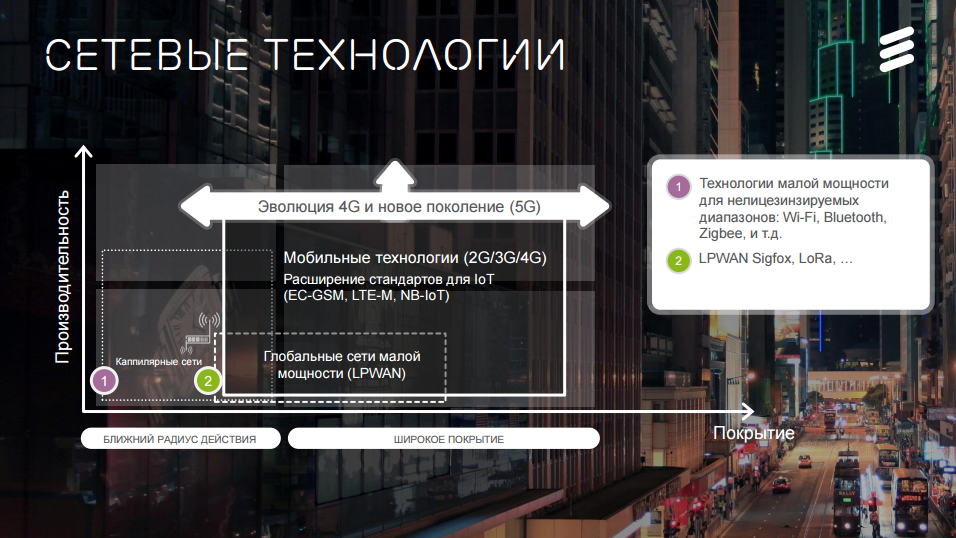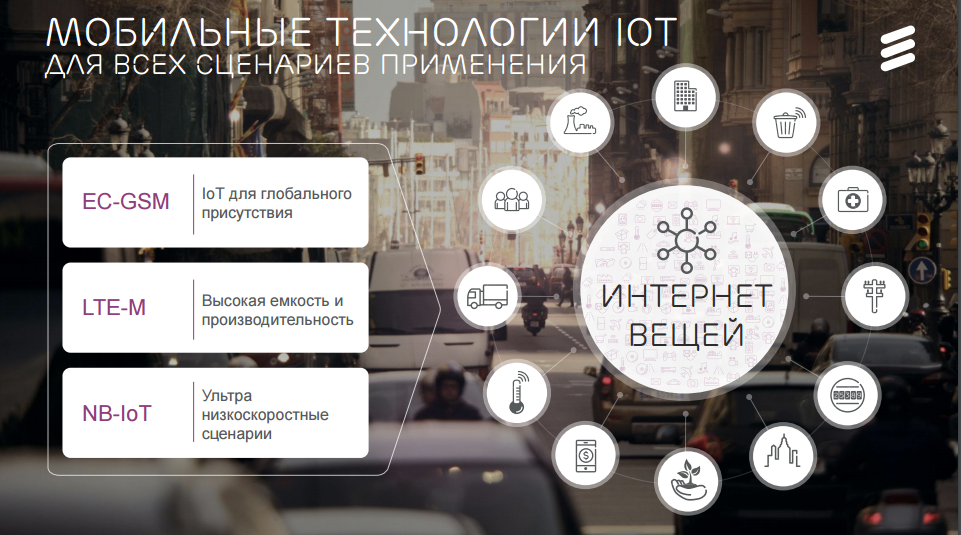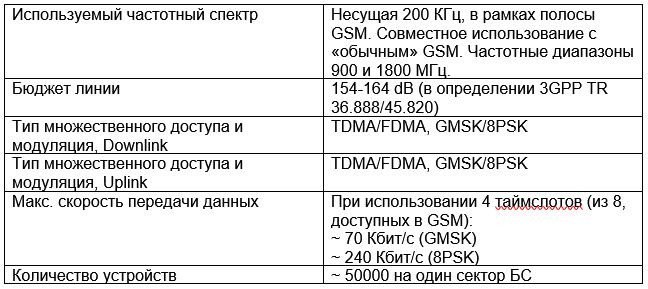IoT networking technology

Good afternoon, dear habravchane! Today we would like to focus on the description of various network technologies being developed for the Internet of Things.
The Internet of Things (IoT, Internet of Things) is becoming the next revolutionary leap in development, comparable to the invention of the steam engine or the industrialization of electricity. Today, digital transformation turns the most diverse sectors of the economy and changes our familiar environment. In this case, as often happens in such cases, the final effect of these transformations is difficult to predict, being at the beginning of the path.
')
The process that has begun, obviously, cannot be even and today some sectors are more ready for changes than others. The first can be attributed to consumer electronics, transport, logistics, financial sector, to the second - for example, agriculture. Although there are successful pilot projects here that promise interesting results.
The TracoVino project, one of the first attempts to use IoT in the famous Moselle Valley, the oldest wine-growing region of modern Germany. The solution is based on a cloud platform that automates all processes in the vineyard, from growing raw materials to bottling. The data necessary for making decisions come into the system from several types of sensors. In addition to determining the temperature, soil moisture and environmental monitoring, they can determine the amount of solar radiation, the acidity of the soil, and the content of nutrients in it. What does this give? TracoVino not only allows winemakers to get a general idea of their vineyard's condition, but also to analyze its specific areas in order to identify problems, get advance information about a possible infection, and even get predictions about the quality and quantity of wine that allows winemakers to enter into forward contracts.
What else can be connected to networks? The most developed scenarios for using IoT include “smart cities”. According to research by Beecham Research, Pike Research, iSupply Telematics and the US Department of Transportation, as part of these projects, there are more than a billion devices around the world that are responsible for certain functions in water supply systems, urban transport management, public health and safety. These are smart parkings that optimize the use of parking spaces, an intelligent water supply system that monitors the quality of water consumed by residents of the city, smart bus stops to get accurate information about the waiting times for the desired transport and much more.
The industry already has hundreds of millions of devices ready to be connected. These include smart maintenance and repair systems, logistic accounting and security, as well as smart pumps, compressors and valves. A large number of devices are involved in the areas of energy and utilities: numerous meters, automation elements of distribution networks, consumer equipment, electrical charging infrastructure and infrastructure for renewable and distributed energy sources. In the field of healthcare, diagnostic tools, mobile laboratories, various implants, and telemedicine devices will be connected to the Internet of Things.

It is expected that in the coming years, the number of machine connections will increase by 25% per year, and by 2021, there will be 28 billion connected devices on the planet by 2021. Of these, only 13 billion will fall on familiar user gadgets: smartphones, tablets, laptops and PCs - while 15 billion will be user and industrial devices: various kinds of sensors, sales terminals, cars, boards, indicators, etc.
Despite the seemingly startling figures from the near future, and they are not final. IoT will be implemented everywhere, and the farther, the more devices, simple and complex, will have to be connected. As technology advances, and especially under the influence of the launch of 5G networks after 2020, the number of connected devices will grow at a rapid pace and will soon approach 50 billion.

The massive nature of the connections and the various usage scenarios dictate the requirements for IoT network technologies in the widest possible range. Data transmission rates, delays, reliability (guaranteed) of transmission are determined by the characteristics of a particular application. Nevertheless, there are a number of common targets that require us to separately consider network technologies for IoT and their differences from traditional mobile networks.
First of all, the cost of implementing the network technology in the end device should be several times less than the existing GSM / WCDMA / LTE modules used in the manufacture of smartphones and modems, even in the most affordable class. One of the reasons hindering the massive introduction of connected devices is the high cost of a chipset that implements a full stack of networking technologies, including voice transmission and many other functions that are not necessary in most IoT scenarios.
Associated with this, but formulated separately, the requirement is low power consumption and long battery life. Many IoT scenarios and applications provide for autonomous powering of connected devices from built-in batteries. Simplification of network modules and energy-efficient design allows you to achieve battery life of up to 10 years with a battery capacity of 5 Wh. Such indicators, in particular, can be achieved by reducing the amount of transmitted data and the use of long periods of "silence", during which the device does not receive and does not transmit information and practically does not consume electricity. However, the implementation of specific mechanisms differs from technology to technology.
Network coverage is another feature that needs to be reviewed. Today, mobile network coverage provides a fairly stable data transmission in human settlements, including indoors. However, the connected devices can be located where people most of the time is not: remote areas, extended railway spans, the surface of extensive reservoirs, basements, insulated concrete and metal boxes, lift shafts, containers, etc. The target benchmark for solving this problem, according to the majority of IoT market participants, is to improve the budget line by 20 dB relative to traditional GSM networks, which are the leader in coverage among mobile technologies today.

Different scenarios for using the Internet of things in different industries imply completely different communication requirements. And it's not just about the possibility of a fast scaling of the network in terms of the number of devices that need to be connected. If in the example of the “smart vineyard” that we described, a number of fairly simple sensors were involved, then industrial enterprises will connect very complex robots that perform actions, and not just fix certain environmental parameters. We can also recall the field of health care, in particular, the equipment for telemedicine. The use of these complexes designed for remote diagnostics, monitoring of complex medical procedures and remote training using video in real time will undoubtedly have completely different requirements in terms of signal delays, data transmission, reliability and security.
IoT technologies must be flexible enough to provide a different set of network characteristics depending on the usage scenario, prioritizing dozens and hundreds of different types of network traffic, and optimal redistribution of network resources to maintain cost-effectiveness. Millions of connected devices, dozens of usage scenarios, flexible management and control - all this should be implemented within a single network.

Numerous recent developments in the field of wireless data transmission, both connected with the desire to adapt existing network architectures and protocols, and with the creation of new system solutions from scratch, are devoted to solving these tasks. On the one hand, we see the so-called “capillary solutions”, quite successfully solving the tasks of IoT communications within a single room or a limited area. Such solutions include today's popular Wi-Fi, Bluetooth, Z-Wave, Zigbee, and their numerous counterparts.
On the other hand, modern mobile technologies, which are obviously out of competition in terms of providing coverage and scalability of well-managed infrastructure. According to the Ericsson Mobility Report study, GSM coverage is 90% of the populated area of the planet, the WCDMA and LTE networks are 65% and 40%, respectively, with the active construction of networks. The steps taken in the development of mobile communication standards, in particular the 3GPP Release 13 specification, are aimed precisely at achieving the target indicators for IoT while retaining the benefits of using the global ecosystem. The evolution of these technologies will be the basis for future modifications of mobile communication standards, including the standards of fifth-generation networks (5G).
Alternative low-power technologies for unlicensed frequency spectrum, in general, are aimed at a narrower application. The need to create new infrastructure and the closeness of technology significantly restrain the proliferation of such systems.


Consider which extensions of mobile communication standards are defined to be included in the latest revision of the 3GPP Release 13 recommendations.
EC-GSM
The working group GERAN, developing GSM technologies, proposed an advanced features package called EC-GSM (variants of the same name: EC-GPRS, EC-GSM-IoT). This technology provides relatively small changes relative to the base GSM / GPRS / EDGE, which allows the use of the vast majority of installed base stations of this standard without replacing or upgrading hardware.
We present the main characteristics:

In fact, the standard GSM / GPRS carrier is used, with changes to increase the line budget, increase the number of devices and reduce the cost of implementing the technology in the final device.
Major changes introduced:
1) Extended DRX (eDRX, Extended Discontinuous Reception) for GSM and Power Saving Mode (PSM ) - reducing the frequency of mandatory signaling messages, optimizing the reception and receiving intervals of information, supporting long, up to 52 minutes, periods of "silence" during which the device remains connected to the network without transmitting or receiving information.
2) Extended coverage is the adaptation of the data link layer of the network, using, among other things, multiple repetition of the transmitted information to improve coverage by 20 dB compared to traditional systems.
3) Other improvements : simplified network signaling (refusing to support the part of the signaling that allows collaboration with WCDMA / LTE networks); expansion of authentication mechanisms and connection security, etc.
The key advantage of EC-GSM is the availability of the network infrastructure (in most cases only software updates on the network nodes are required), as well as the prevalence of GSM networks and their coverage.
eMTC
The eMTC variant (also called LTE-M, LTE Cat.M1) is an IoT adaptation for LTE networks. The focus is still on achieving mass IoT targets (cost, coverage, battery life) while ensuring maximum compatibility with the existing network infrastructure of the operators.
An important difference of eMTC technology is high bandwidth, up to 1 Mbps in each direction (from subscriber to subscriber). It's time to recall the variety of IoT usage scenarios that we addressed at the beginning of the article. In certain cases, such data rates will be clearly claimed.

eMTC is designed to reduce the cost of the end IoT device by eliminating the LTE functionality, which is in demand and is widely used in mobile broadband access networks (MRTD), but becomes redundant with mass connection of IoT devices. This is a continuation of the work begun by 3GPP in the previous release of specifications (Release 12), which defined LTE Cat.0 for IoT. EMTC also added Extended DRX and PSM mechanisms for LTE, which solve the problem of reducing power consumption in the same way as was shown above for EC-GSM.
As in the case of EC-GSM, eMTC has a high degree of network infrastructure availability and can be deployed on existing LTE networks by updating software. Moreover, the MSTD and IoT networks can coexist and dynamically redistribute the resources used (frequency spectrum, base station computing power, etc.) depending on the type and number of connected devices and the traffic they generate.
NB-IoT
Narrowband IoT (narrowband IoT) is a relatively new direction in the development of networked IoT technologies and despite the fact that its use provides for close interaction and integration with LTE, it is still about creating a new type of radio access, the characteristics of which have more differences than similarities with available technologies.

It is expected that significant processing of data link layer protocols will reduce the cost of the NB-IoT device compared to LTE Cat.M1 by 90%. NB-IoT technology support in their products has already been declared by many manufacturers of network equipment and subscriber modules: Ericsson, Huawei, Nokia, Intel, Qualcomm, as well as leading telecom operators, including, for example, Vodafone, Deutsche Telekom and China Unicom.
Thus, with the adoption of the final version of the EC-GSM, eMTC and NB-IoT specifications, which is scheduled for June of this year, market participants will have at their disposal three effective tools for the development of IoT networks. Each of them has its own characteristics and advantages depending on the specific use case and characteristics of the mobile network on the basis of which they will be deployed. However, in any case, the advantages of the global ecosystem, the availability and readiness of the deployed network and IT infrastructure, the use of a protected (licensed) frequency spectrum will work to reduce the cost of implementation and operation. So, in the near future, we expect an explosive growth of projects with their use.
On it we will finish the story and we thank habravchan for attention! In the next post, we will focus on the technological aspects of NB-IoT technology.
Source: https://habr.com/ru/post/301494/
All Articles